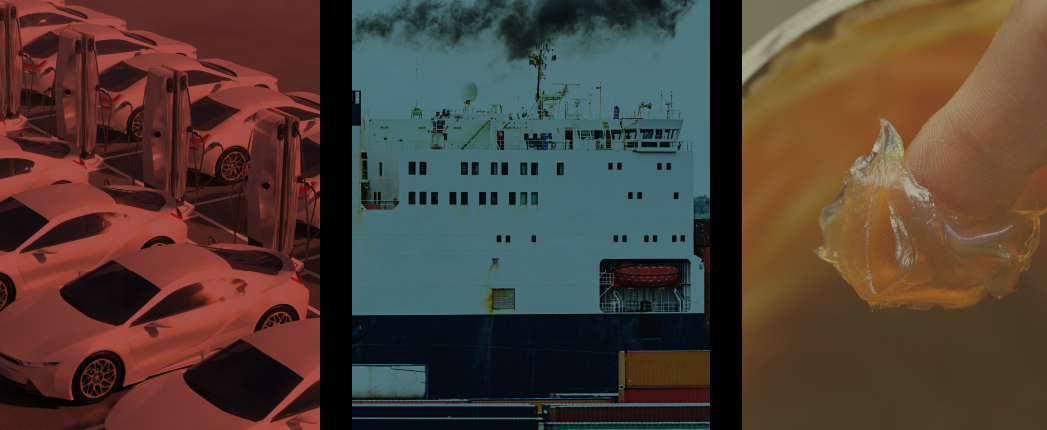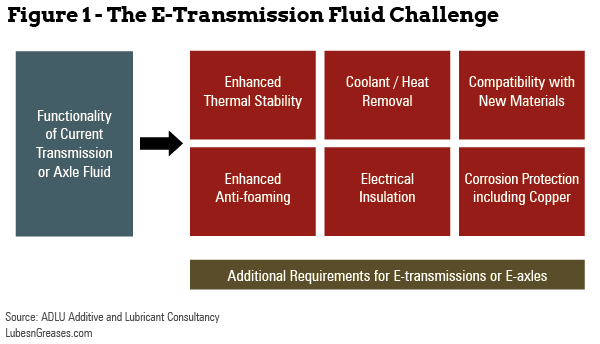
The December 2021 issue of Lubes’n’Greases examined the use and limitations of bench tests for lubricants. This article explores the use and value of bench tests to support solutions to new lubrication challenges for greases, marine lubricants and electrified applications.
As the search for solutions to the issues of climate change, air quality and emissions gains urgency, lubrication is playing a vital role. And new challenges are continually turning up. In greases, energy efficiency and electrical component compatibility are emerging requirements. In marine engines, the use of alternative fuels is creating new lubrication demands. In e-fluids, good thermal properties and compatibility with electrical systems and associated hardware is crucial.
The changing landscape for lubricants and greases means needs are evolving for bench tests, small-scale tests that examine a specific aspect of a lubricant’s performance.
“Bench tests are indeed a valuable tool for evaluation of new additives and formulations,” Cyril Migdal, vice president application technology for Lanxess, told Lubes’n’Greases. “They should always be employed as an initial screener before conducting tests” with original equipment manufacturers’ hardware.
To help formulators and additive component and package developers meet the challenge, new bench tests are being developed to enhance system understanding and support rapid new product development.
New Grease Applications
For lubricating grease, a wide range of industry standard and proprietary bench tests have long been used in support of product characterization, development and as the framework for specifications. “The extent to which they reflect real-world application conditions does vary,” Mark Wheeler of Axel Christiernsson International A.B. told Lubes’n’Greases.
“This should not be a surprise given that for many of the early grease tests, the scope of their development was only ever limited to characterizing specific product properties in isolation, such as product consistency or tendency to bleed oil,” Wheeler said. “They were never designed to determine application suitability.”
Grease testing has a long history,Wheeler noted. “The origins of its most widely used and commonly referenced test method—the ASTM D217 Cone Penetration test—extends back over 100 years.”
Advances in engineering combined with the need for closer links between bench test performance and in-service benefits have since resulted in the development of far more complex component- and contact-based tests. These enable multiple aspects of grease performance to be evaluated simultaneously.
Such tests—including the FAG FE-8, SKF R2F, SRV (ASTM D 5707) and MTM—have enhanced application relevance through the evaluation of grease performance in a context more reflective of the real world. “They have also improved our understanding of how fundamental grease properties, as measured by the older, more established tests, can also impact grease performance, thus increasing their value, too,” Wheeler said.
Energy efficiency affects many aspects of everyday life. From a lubrication perspective, its importance has been brought into sharp focus by the recent and rapid growth of the electric vehicle segment. The direct relationship between energy losses and vehicle range in this sector has highlighted the need to demonstrate how greases can contribute to improved energy efficiency. With energy loss in lubricated components being largely attributable to a combination of friction and churning effects, the creative use of relevant bench tests along with more advanced techniques that explore material flow, like rheology, have the potential to support a relevant story around energy efficiency.
EVs have also introduced more novel challenges, including the increased potential for static buildup and its uncontrolled discharge, which can adversely affect lubricants and components alike.
Vehicle OEMs are still exploring a variety of hardware engineering solutions, so direct relationships with them can be advantageous when developing greases for applications that are still evolving.
New Marine Lubricant Applications
The International Maritime Organization continues to establish regulations for reducing emissions from ships. The allowable levels of nitrous and sulfur oxides are being reduced, and the next aim is to have a 50% reduction in international shipping’s carbon dioxide emissions by 2050. This provides the impetus for new fuel types, like liquefied petroleum gas, methanol, ammonia and hydrogen. These new fuel types create different lubrication challenges for marine engines. There are no industrywide specifications for marine lubricants, either for 2-stroke or 4-stroke engines. Bench tests are an important part of the formulation development process to screen formulations because the final OEM approval is based upon expensive and lengthy ship field trials. As the timelines to find answers to emissions issues shorten, this creates the need for rapid understanding of mechanisms and screening of formulations.
“A range of tests are utilized that can provide direction in terms of formulation development,” Ian Bown, technical manager marine diesel engines for Lubrizol, said. “It allows us to ‘filter’ new lubricants until we are ready to test in a static engine. Ultimately, we can share this information with our customers, OEMs and ship owners to demonstrate the robust processes employed prior to placing an oil in a ship.”
Methanol as a fuel has the benefit of reducing nitrous and sulfur oxide emissions and particulates versus current refinery fuel sources. But methanol fuels may lead to concerns about water ingress, emulsion formation or metal corrosion. Several industry bench tests are available to examine such parameters. “These issues are not simply for the cylinder lubricant in a two-stroke marine engine,” Bown said. “When we first studied methanol and lubricant interactions in our bench tests, we observed emulsification of the system oil with methanol. This was a potential problem, as the system oil, which also acts as the hydraulic oil for some systems in a marine engine, provides some of the sealing within the fuel valves.”
Ammonia as a fuel has the advantage of emitting zero carbon dioxide when combusted and could help in meeting the IMO target. But it has corrosive tendencies that need further understanding through research, including proprietary bench testing. “We’ve been gathering information, as we know ammonia has a tendency to corrosivity,” Bown said. “We are determining which components will be affected, starting by exposing metal engine parts to ammonia, particularly coated parts, like piston rings.”
E-driveline Fluids
For transmissions and axles, bench tests have been widely used to evaluate oxidation, friction, wear and seal compatibility. New e-transmission systems, which can run at up to 20,000 rpm, create additional challenges in understanding how the fluid interacts with the electric motor and associated components (Figure 1).
“The development of e-driveline fluids has relied heavily on industry standard bench tests that have been used in the development of traditional driveline fluids,” Suzanne Patterson, Lubrizol’s technology development manager, told Lubes’n’Greases.

“There is agreement in the industry that the FZG scuffing and pitting bench test methods provide a suitable assessment of gear durability. Standard elastomer and foam testing are still important.”
Afton Chemical’s marketing manager for e-mobility, Adam Banks, said: “Aspects of e-mobility are new and connections between the laboratory and real world are not well understood, compared to more established issues. Everyone is developing new bench tests, but there will be hits and misses. We should be aiming to develop solutions for applications in the real world, rather than to satisfy esoteric tests.”
The ASTM D130 bench test has been widely used across the industry. It uses a copper strip immersed in the test fluid that is then rated for corrosion level. There are questions about test variability and its relationship to in-service performance. For e-driveline fluids, new copper compatibility and corrosion bench tests have been developed.
Corrosion in the vapor phase is a topic of interest. Afton is “taking wound copper wires, suspended above the oil in sealed tubes and connected to a current” as a new bench test for copper corrosion, Banks said. The method can also be used with other metals, like silver. “With some lubricants, wire sections exposed to air are completely destroyed sooner than in an equivalent submerged test,” he said. “The negative consequences are obvious.”
Lubrizol has also developed a copper wire test to assess corrosion in both oil and vapor phases. “Additionally, a conductive layer deposit test can assess the formation and impact of conductive corrosion byproducts,” said Tim Newcomb, strategic technology manager at Lubrizol. “Work is also underway to develop magnet wire insulation tests, high-speed bearing and aeration tests.”
Infineum “has used a number of bench tests, including ASTM D130 and newer proprietary energized circuit board tests, to screen additives to ensure good copper compatibility,” Zhao Gang, the company’s PTF portfolio manager, told Lubes’n’Greases. Various OEM-specific test methods are being devised for compatibility with other materials, including plastics, wire coatings and lacquers.
The ASTM D1169 bench test is widely used to measure the resistivity of fluids and electrical compatibility. “The measurement of electrical properties has become pertinent, especially for hardware in which the fluid is exposed to the motor, power electronics or battery,” Newcomb said. “Bench tests for electrical conductivity, dissipation factor, dielectric constant and breakdown voltage now appear in some OEM specifications.”
Getting the balance right is vital. “Too low, and power outage may result; too high, and it can lead to static charge build-up and hardware damage due to arcing phenomena,” Zhao Gang said. “E-fluids with the optimal resistivity result in low current leakage, which can help OEMs to reduce the size of the casing through smaller e-motors operating at even higher voltages.”
Several ASTM tests for thermal properties are applicable. “As e-devices move toward using the lubricant as a thermal management fluid, development of e-driveline fluids now incorporates use of thermal conductivity and heat capacity bench testing,” Newcomb said.
Battery Coolant Fluid
As EV batteries become more powerful and faster charging is needed, new battery coolants are being developed. Batteries have optimal efficiency in the range of 15 to 35 degrees Celsius. Higher temperatures must be avoided. Direct contact between fluid and battery is the most efficient method to avoid overheating, which can damage the battery lifetime and cause safety issues.
In the emerging field of battery coolants, few standard test methods exist and new bench tests have been devised to better understand the system dynamics and fluid properties. “The first bench test the company developed took a dummy heated electrical cell with a gap between cell and casing through which fluid flows, mimicking heat dissipation in a fast-charging scenario,” Nicolas Champagne, chemist at TotalEnergies, told Lubes’n’Greases.
Then a second bench test was scaled up to include a full battery pack simulation. “This allowed us to examine further variables,” Champagne said. “We varied the gap between the cells, contact area, fluid flow rate and critically the fluid properties of thermal conductivity, heat capacity and density. This allowed the best candidate fluids to progress to more wide-ranging testing and field trials, subsequently resulting in successful development of a new battery coolant fluid.”
Philip Reeve is a chemist with 40 years of experience in the global lubricants and additives industry. He’s held positions at Afton, Infineum and ExxonMobil and is now a director of ADLU Consultancy. Contact him at philipreeve@adlu-consultancy.com.
|
For more information about the interface between lubricants and the EV market visit Electric Vehicles InSite.
|
